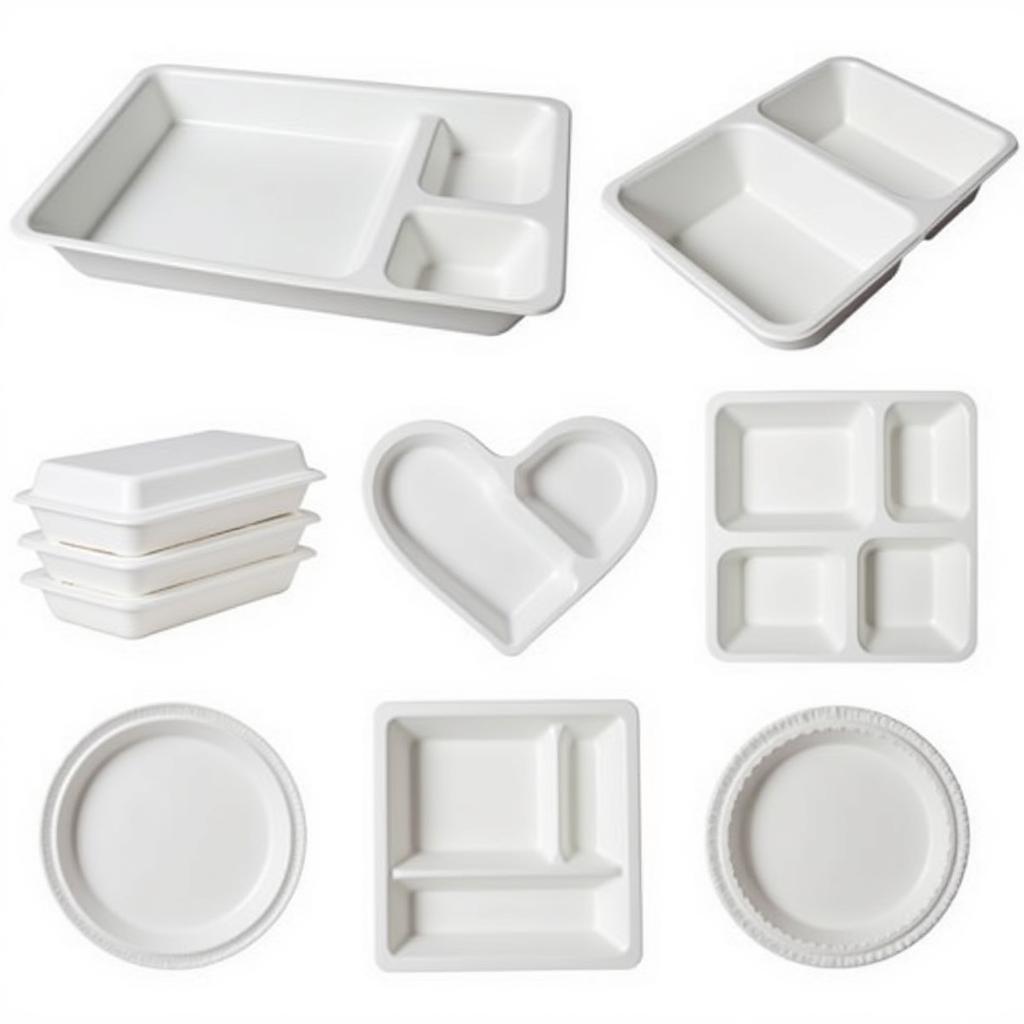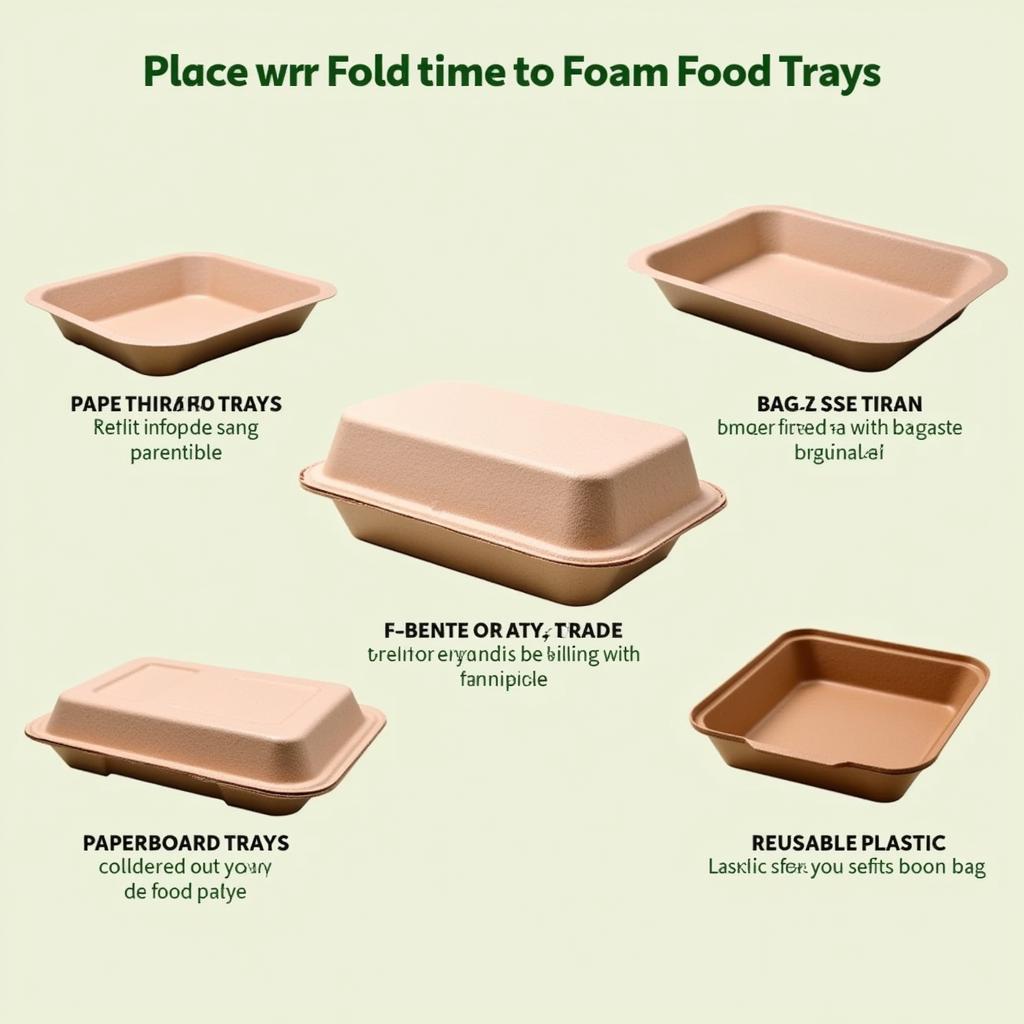Foam Food Trays have become a ubiquitous part of the food service industry, offering a convenient and cost-effective way to serve everything from hot meals to fresh produce. But are they the right choice for your business? This comprehensive guide explores the pros and cons of foam food trays, delving into their versatility, sustainability, and the various alternatives available. We’ll also examine the different types of foam food trays, helping you make an informed decision for your food packaging needs. Let’s explore the world of foam food trays and discover the best options for your business.
Understanding the Different Types of Foam Food Trays
Foam food trays come in a variety of shapes, sizes, and materials. Understanding these differences is key to selecting the right tray for your specific application.
Expanded Polystyrene (EPS) Foam Trays
This is the most common type of foam food tray. EPS trays are lightweight, inexpensive, and offer excellent insulation, making them ideal for hot or cold food. They are also readily available in various sizes and shapes, catering to diverse food service needs.
Polypropylene (PP) Foam Trays
PP foam trays are a newer alternative to EPS trays. While slightly more expensive, they offer several advantages. They are more resistant to cracking and breaking, and can withstand higher temperatures than EPS. PP foam trays are also recyclable in some areas, making them a more sustainable option.
Biodegradable Foam Trays
For businesses seeking eco-friendly options, biodegradable foam trays are becoming increasingly popular. These trays are made from plant-based materials like sugarcane or cornstarch, reducing reliance on petroleum-based products. While they often cost more than traditional foam trays, the environmental benefits are significant.
After considering different tray types, you might want to explore other food packaging options like kraft food trays.
The Pros and Cons of Foam Food Trays
Like any packaging material, foam food trays have their advantages and disadvantages. Let’s weigh them out:
Advantages
- Cost-effective: Foam trays are typically less expensive than other disposable food containers, making them a budget-friendly option for businesses.
- Insulating properties: Foam trays effectively maintain food temperature, keeping hot food hot and cold food cold.
- Lightweight: Their lightweight nature reduces shipping costs and makes them easy to handle.
- Versatile: Available in various shapes and sizes, foam food trays can accommodate a wide range of food items.
Disadvantages
- Environmental concerns: Traditional EPS foam trays are not easily recyclable and can contribute to landfill waste.
- Durability: While lightweight, foam trays can be prone to cracking or breaking, especially when carrying heavier food items.
- Absorption: Some types of foam can absorb liquids, potentially affecting the quality and presentation of certain foods.
If you’re concerned about the environment and durability, you may want to check out cardboard food containers.
 Variety of foam food trays for different food service needs
Variety of foam food trays for different food service needs
Are Foam Food Trays Sustainable?
The sustainability of foam food trays is a complex issue. Traditional EPS foam is not biodegradable and takes hundreds of years to decompose in landfills. However, advancements in biodegradable foam technology offer more environmentally friendly alternatives. These options, often made from plant-based materials, compost more readily, reducing their environmental impact. Choosing sustainable packaging is crucial. For bulk purchasing of eco-friendly options, explore our range of food packaging supplies wholesale.
What are the Alternatives to Foam Food Trays?
Several alternatives to foam food trays exist, each with its own set of benefits and drawbacks.
- Paperboard trays: These are a recyclable and biodegradable option, but they may not offer the same level of insulation as foam.
- Bagasse trays: Made from sugarcane fiber, bagasse trays are compostable and offer a sturdy, eco-friendly alternative.
- Plastic trays: While reusable in some cases, plastic trays also contribute to environmental concerns if not properly recycled.
Consider switching to eco-friendly alternatives such as disposable bowls for hot food.
 Eco-friendly alternatives to traditional foam food trays
Eco-friendly alternatives to traditional foam food trays
Choosing the Right Foam Food Tray for Your Business
Selecting the appropriate foam food tray involves considering several factors.
- Type of food: Hot foods require trays with good insulation, while cold foods may prioritize moisture resistance.
- Size and shape: Consider the portion sizes and presentation needs of your food offerings.
- Budget: Foam trays are generally cost-effective, but biodegradable options may be more expensive.
- Sustainability goals: Align your choice with your business’s commitment to environmental responsibility.
Why is Presentation Important with Foam Food Trays?
While seemingly simple, the presentation of food in foam trays can significantly impact customer perception. A well-presented meal, even in a disposable container, enhances the dining experience. Consider using different compartments within the tray to separate food items, preventing them from mixing and maintaining an appealing visual.
Conclusion
Foam food trays offer a practical and cost-effective solution for many food service businesses. However, considering the environmental impact and exploring sustainable alternatives is essential. By carefully evaluating your needs and priorities, you can choose the best foam food tray or alternative that balances functionality, cost, and environmental responsibility. Ultimately, the right choice will depend on your specific business requirements and commitment to sustainability. Consider the versatility of foam trays and other options like fast food bags for a complete packaging solution.
FAQ
- Are all foam food trays recyclable? No, traditional EPS foam trays are not easily recyclable. However, biodegradable options are available.
- What are biodegradable foam trays made of? They are often made from plant-based materials like sugarcane or cornstarch.
- Are foam food trays microwave-safe? It depends on the type of foam. Check the manufacturer’s instructions.
- What are the best foam food trays for hot foods? EPS foam trays offer excellent insulation for hot foods.
- Are there any health concerns associated with foam food trays? While generally safe, some concerns exist about chemicals leaching into food under high temperatures. Choose reputable suppliers and follow usage guidelines.
- How can I dispose of foam food trays responsibly? Check local regulations for proper disposal guidelines.
- What are the most cost-effective foam food trays? Traditional EPS foam trays are typically the least expensive.
Common Scenarios and Questions:
- Scenario: Catering a large event. Question: What’s the most cost-effective and efficient way to serve food using foam trays?
- Scenario: Running a food truck. Question: What are the best foam food trays for handling different types of food on the go?
- Scenario: Owning a restaurant. Question: How can I improve the presentation of my takeout meals using foam food trays?
Further Reading and Resources:
Explore our other blog posts about sustainable food packaging options and innovative solutions for your business.
Need Help?
For any further assistance or inquiries, please contact us at Phone Number: 02437655121, Email: minacones@gmail.com or visit us at 3PGH+8R9, ĐT70A, thôn Trung, Bắc Từ Liêm, Hà Nội, Việt Nam. Our customer service team is available 24/7 to assist you.